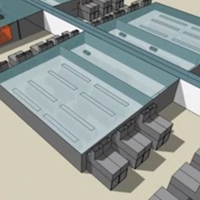A Datacenter Without Walls
When you're running the largest datacenters in the world, low-carbon cooling techniques take on new significance. Microsoft knows all about large-scale IT operations; the company has been operating datacenters since 1989. While primarily regarded as a software vendor, Microsoft's stake in the Internet Explorer browser gave the company an early connection to the online world. Today, Microsoft's cloud-based infrastructure supports more than 200 online services and counts over one billion customers from around the world.
 In the datacenter boom days of the dot-com era, temperature control was the name of the game. Rigorous environmental controls were enacted to remove heat from the computing elements in order to prevent equipment malfunction. This was an expensive undertaking, from both an economic and environmental perspective.
In the datacenter boom days of the dot-com era, temperature control was the name of the game. Rigorous environmental controls were enacted to remove heat from the computing elements in order to prevent equipment malfunction. This was an expensive undertaking, from both an economic and environmental perspective.
From 2004-2007, Microsoft began designing facilities with an emphasis on enabling rapid deployment and more efficient operations. In 2007, Microsoft opened its first generation-two datacenter in Quincy, Washington, paving the way for future large-scale Internet-based datacenters. Today the infrastructure has grown to an area the size of ten football fields. It includes tens of thousands of processing and storage servers – all powered by 100 percent renewable hydro-power.
With the growth of the company's Azure cloud and other Internet-based services, Microsoft has taken its datacenter strategy to the next level by setting up next-generation IT operations across the world. The geographically-distributed footprint puts datacenters close to customers to reduce latency.
As Microsoft has rolled out third and fourth-generation datacenters, the company has transitioned to a modular building approach, remarking on its efficiency and sustainability. These modular computing units are known as ITPACs (pronounced IT-Packs) – short for IT Pre-Assembled Components.
Each ITPAC contains more than 400 servers. Microsoft notes that the modular design strategy allows for additional compute capacity to be added quickly, reducing typical construction times from two years down to 12 months and lowering capital costs by 30-50 percent over the lifetime of the facility.
The latest phase of Microsoft's Quincy, Washington, datacenter is the most radical yet, and the most energy-efficient with less than half the carbon footprint of traditional datacenters, according to company claims. The outer building has virtually disappeared – think data warehousing without the warehouse. ITPACs are sited on concrete slabs and hooked up to power and the Internet. They sit out in the open, allowing cool air to pass through the modules, thus removing the heat from the servers that make up the Azure cloud.
The technology is called air-side economization. It's described by Microsoft in a 10-minute video (see below):
"Air handling units on the roof draw in cold outside air to provide the cooling for the servers and facility. Evaporative coolers vaporizing water into the air to absorb heat and an air-bypass feature improves maintains room temperature regardless of outdoor conditions. The facility uses less than one percent of the annual water consumption of a traditional datacenter."
Referring to its Quincy-based fourth generation technologies, the company says: "Our simple recyclable metal building provides shelter from weather and directs proper airflow through hall systems. The approach allows us to deliver PUEs of 1.15 to 1.2 across the facility."
A datacenter's power-usage effectiveness, or PUE, can be figured out by taking the total power entering the datacenter and dividing by the power used by the IT equipment. The average datacenter in the United States has a PUE of about 2.0.
Despite the open design, security has not been sacrificed. Each ITPAC unit forms its own secure steel perimeter, while a patrolled outer perimeter provides another line of defense. Other security elements include two-factor access control, badge readers, extensive camera monitoring and integrated alarm systems. Data is classified based on its value and protected accordingly. Hard drives containing sensitive material are routinely destroyed during the decommissioning process. Access to facilities is limited to those with valid business needs.
Microsoft also employs third party verification to verify its capabilities and has a range of ISO and PCI certifications, and SAS 70 Type II attestations and FISMA accreditation.
Take a virtual tour of the 'Microsoft Cloud' and the Windows Azure datacenters with this 10-minute video from Microsoft. Microsoft describes how its modular approach has resulted in increased energy efficiency and sustainability and significantly reduced the time it takes to deploy huge amounts of computing power.










